RRR25: The Griddle Laboratory, Company Culture, Photosynthesis, The Necessity of Necessity, and NBA Summer League Thoughts
🥓🍴👨🏻💼🌱😎🏀
In my life, I’ve most often cooked for necessity. If I have a little extra time to experiment then that’s great.
But more recently, I’ve been working to optimize for enjoyment and taste.
Cooking on a griddle has given me the opportunity to do both:
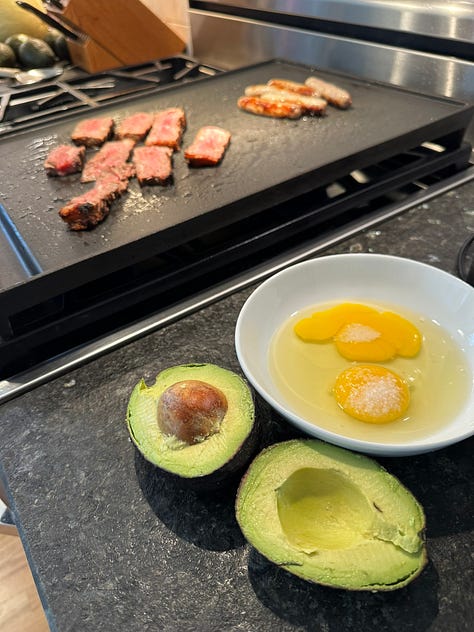
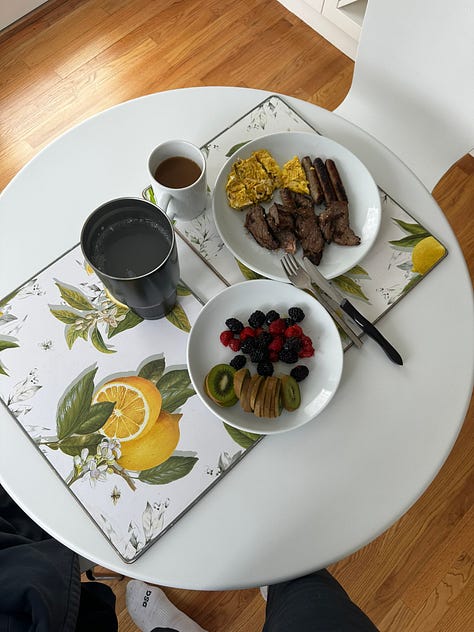
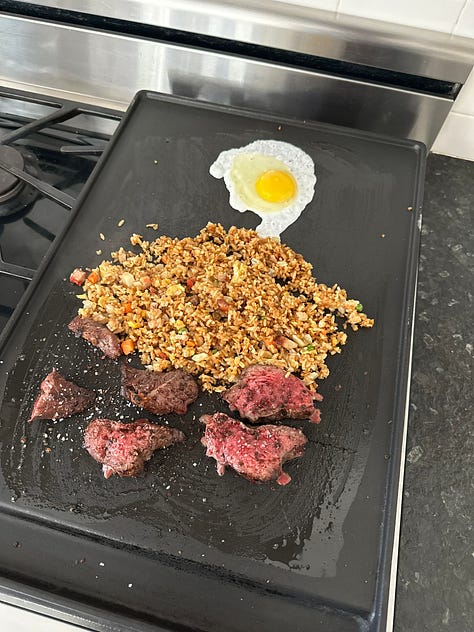
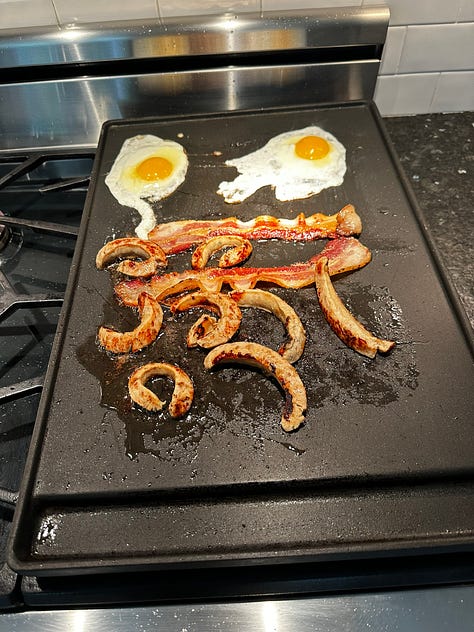
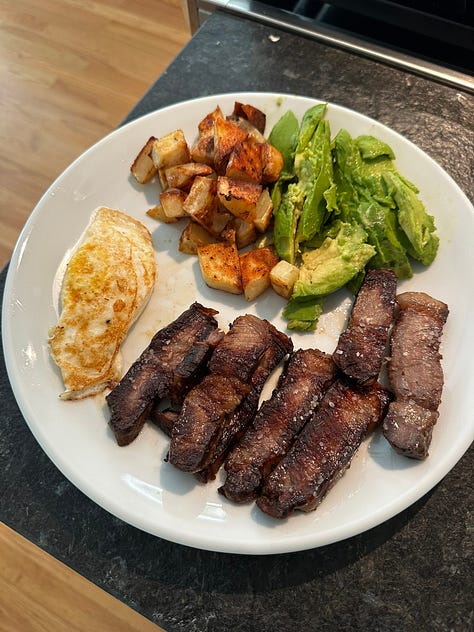

As it pertains to the finest attributes of the griddle, there is much to choose from. Here are a few points of emphasis:
It heats quickly and evenly, ensuring that the food cooks as anticipated. This might vary depending on the brand - I’m not sure which kind I have. I inherited it.
You can cook a large quantity of things all at once. It’s no hassle if you’re making breakfast for two or three people!
It’s remarkably easy to clean. Once it cools down, cleaning it with soap and water works fine. If you burn something, a little powder cleanser will do the trick. Clean as a whistle.
It has me thinking about what other variations of cookware I might not know I’m missing… 😉.
In Recent Times…
I was thinking recently about company culture. Specifically, I pondered what makes the culture of an organization “good”, and what factors can make it “bad”?
In order to get there, I asked myself:
If, for a moment, I likened my life to that of an organization, what would I want the culture to feel like?
The first thing I came up with was that I should cultivate a high trust environment. To me, trust isn’t about keeping secrets or knowing that you’ll do something you’ve been tasked with.
In fact, I think it might be the opposite!
I want to have so much trust in my organization that we don’t need to have secrets. I should know that if I have to tell you something good or bad, you’ll react reasonably, and vice versa.
If I ask you to do something without merit, I trust that you’ll tell me it’s bad idea. I trust you’ll help me understand why that’s the case.
I also would want my organization to be a place where learning is not just encouraged, but it’s core to operations. Not knowing something is never a bad thing, as long as it’s acknowledged as a blind spot.
Additionally, for the organization to have a culture of innovation, we need to encourage the free expression and testing of different ideas.
A collaborative spirit is essential — are you able and willing to work effectively with others?
Finally, the DNA strand most critical to my organization would be that when we work hard together, we also need to have fun together.
After we help each other pursue our dreams and live happier, healthier, and more meaningful lives, we better celebrate it together.
What are some things you want to foster in the culture of your life?
Content Corner 📖🎙📺
Creating a Better Leaf, by Elizabeth Kolbert (2021)
Photosynthesis has governed the laws of plant growth (at least to our knowledge) for billions of years. Yet, it’s a fairly inefficient process:
Photosynthesis takes place within a plant’s chloroplasts—tiny organelles that are the descendants of that original captured cyanobacterium. When a photon is absorbed by a chloroplast, it initiates a cascade of reactions that convert light into chemical energy. These reactions are mediated by proteins, which are encoded by genes. Through a second series of reactions, the chemical energy is used to build carbohydrates. This requires more proteins. Photosynthesis has been called “one of the most complex of all biological processes,”…
Could it be that evolution has failed these plants? What if there were a more efficient way to grow plants without over-modification of their genes?
Stephen Long, a plant biologist who leads the RIPE (Realizing Increased Photosynthetic Efficiency) project, has spent an incredible amount of time and energy looking into this. He and his colleagues developed a mathematical model that helped them simulate plant growth accurately using all the calculations that happen during photosynthesis.
As a result, they were able to test and learn at a rapid clip:
Once his model, which he dubbed e-photosynthesis, was up and running, Long could create new leaves without the bother of actually growing anything. He could probe the weaknesses of photosynthesis and test possible fixes.
What would happen, for example, if a certain gene were ginned up to produce more of a certain enzyme? Would this accelerate photosynthesis or just gum up the works? The model would analyze the results of each virtual intervention, or hack. “Of course, ninety-nine times out of a hundred you’re making things worse,” Long said.
It was the hundredth hack that kept things interesting. Long found that, by rejiggering certain steps, nature could be improved upon. In 2006, he published a paper outlining half a dozen “opportunities for increasing photosynthesis.”
Among the people intrigued by the idea were some high-level staff members at the Bill and Melinda Gates Foundation. In 2011, the foundation invited Long and some of his colleagues to Seattle to discuss their work. Six months later, the foundation invited the group back.
Long and his collaborators spent a week on Bainbridge Island, in Puget Sound, drawing up a funding proposal, and on the last day of their stay they presented their pitch to Bill Gates. In 2012, the foundation awarded them twenty-five million dollars, and ripe was created. Later, the project received additional funding from Britain’s Foreign, Commonwealth, and Development Office and from the Foundation for Food and Agriculture, a joint public-private venture based in Washington, D.C.
The article also gets into other interesting work in the domain of crop resilience, such as the C4 Rice Project and others.
Solitude and Leadership, by William Deresiewicz (2010)
This piece is a transcription of an old speech Deresiewicz gave at West Point Academy:
I find for myself that my first thought is never my best thought. My first thought is always someone else’s; it’s always what I’ve already heard about the subject, always the conventional wisdom. It’s only by concentrating, sticking to the question, being patient, letting all the parts of my mind come into play, that I arrive at an original idea. By giving my brain a chance to make associations, draw connections, take me by surprise. And often even that idea doesn’t turn out to be very good. I need time to think about it, too, to make mistakes and recognize them, to make false starts and correct them, to outlast my impulses, to defeat my desire to declare the job done and move on to the next thing.
And on reading books vs. other “short-form” content (like this newsletter 😳):
So why is reading books any better than reading tweets or wall posts? Well, sometimes it isn’t. Sometimes, you need to put down your book, if only to think about what you’re reading, what you think about what you’re reading. But a book has two advantages over a tweet. First, the person who wrote it thought about it a lot more carefully. The book is the result of his solitude, his attempt to think for himself.
Second, most books are old. This is not a disadvantage: this is precisely what makes them valuable. They stand against the conventional wisdom of today simply because they’re not from today. Even if they merely reflect the conventional wisdom of their own day, they say something different from what you hear all the time. But the great books, the ones you find on a syllabus, the ones people have continued to read, don’t reflect the conventional wisdom of their day. They say things that have the permanent power to disrupt our habits of thought. They were revolutionary in their own time, and they are still revolutionary today. And when I say “revolutionary,” I am deliberately evoking the American Revolution, because it was a result of precisely this kind of independent thinking. Without solitude—the solitude of Adams and Jefferson and Hamilton and Madison and Thomas Paine—there would be no America.
The Necessity of Necessity
Have you ever reflected on another time in your life where you accomplished something big, and thought to yourself — “how did I do that?”
Perhaps it was a tangible accomplishment, like learning a new skill, landing a new job, or thriving in a difficult situation.
Maybe it was getting yourself out of a depressed or self-sabotaging state of mind over a period of time.
Chances are, you needed that moment of transformation in your life.
It seems to me that when we have our backs against a wall, we become more capable and willing to take risks, challenge our habits, and change.
Conversely, when you’re sailing the calm waters of a life without necessity, complacency sets in and we stop ourselves from turning into different and better people.
Abraham Maslow once said, “In any given moment we have two options: to step forward into growth or step back into safety”.
This is not to say safety doesn’t have usefulness in our lives.
Instead, we only need to be cognizant not to let ourselves relish too much in comfort, and iterate on ourselves from time to time.
NBA Summer League + Team USA’s Unconvincing Play
We’re well into NBA Summer League — what a strange installation it has been.
For context, here’s what Kevin O’Connor of The Ringer had to say about this year’s draft class before the summer league began:
Looking at this year's draft class is like heading to your favorite steakhouse only to find out they’re out of steak. Sure, there are still plenty of other delicious options: your trusted bigs, two-way upside wings, and guards who can cook up their own shots.
But there’s no Wagyu porterhouse like Victor Wembanyama last year. There isn’t even a consensus on which entrées are the best. Teams will need to make the most of the available menu items to find talent and the best supporting pieces to add to their existing cores.
Organizational objectives and philosophies will lead to more disagreement than usual on draft boards, and that’s no different with my own rankings. Lots will change between now and June 26 (and June 27, thanks to the first two-day draft).
Predictably, many of the top draft picks from the most recent rookie class of NBA players have not been overly impressive, with some of them being downright terrible.
On the other side of the coin, you have second year players that are clearly too good to be playing summer league. Still, hats off to them that they even wanted to participate and work on their game with some live competition.
Here are a couple of takeaways:
The Good:
Second year player Cam Whitmore looks far too comfortable against this level of competition. The Houston Rockets may have an interesting dilemma on their hands given the abundant depth of young talent they have on their roster. There is only so much playing time to go around…
Reed Sheppard, also of the Rockets, looks like he’s going to be one of the few rookies to be able to contribute right away in the NBA. He’s a key player for their summer roster and is playing within himself, which is a great sign for young players who are far too often looking to prove themselves.
Stephon Castle — rookie for the Spurs who is clearly going to be a top tier defensive guard in the NBA. We’ll see how his offensive game matures, but his defense is incredible at the point of attack. Just ask the NBA champion Boston Celtics how important that is.
The Bad:
Rob Dillingham, the 8th overall pick in the most recent NBA draft, shoots a lot, misses a lot, and doesn’t project to be an impactful defender. He’s currently shooting 14-51 (27%) on his summer league attempts 🤢.
Alex Sarr, the number 2 pick in the draft, is shooting 19% through his first 21 shot attempts. Yikes.
Takeaways:
I think the winning draft strategy for NBA teams this year was to take players with less flashy potential, but more solid foundations for how they could contribute to winning NBA basketball. There just wasn’t a lot of star power available, so securing average to above average rotation players will have proved a great bargain for most NBA teams this year.
Quick Look at Team USA:
The USA Olympic team improved to 4-0 in it’s international friendly schedule after squeaking out a lackluster victory against South Sudan 101-100.
Despite the overwhelming talent on the roster, they have struggled to hit their stride and play consistently great basketball.
From what I’ve seen, they look much better playing quickly, getting into transition offense, and putting pressure on the ball defensively.
When they slow down and play in the half-court, the opposition appears much more comfortable.
Joel Embiid feels like a weird fit due to his playstyle, and I don’t really love the two-center lineups that Steve Kerr keeps playing. More shooting and playmaking ability on offense would be great.
I think ideally, come the games that matter, they would start Curry, Edwards, Durant, James, and Davis. Let’s see what happens!


